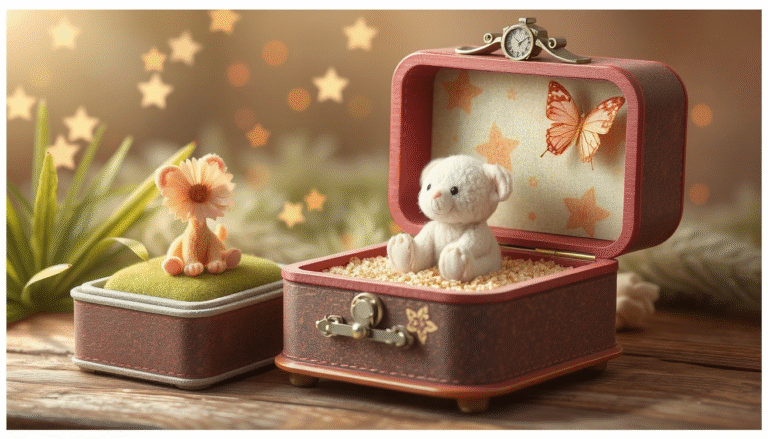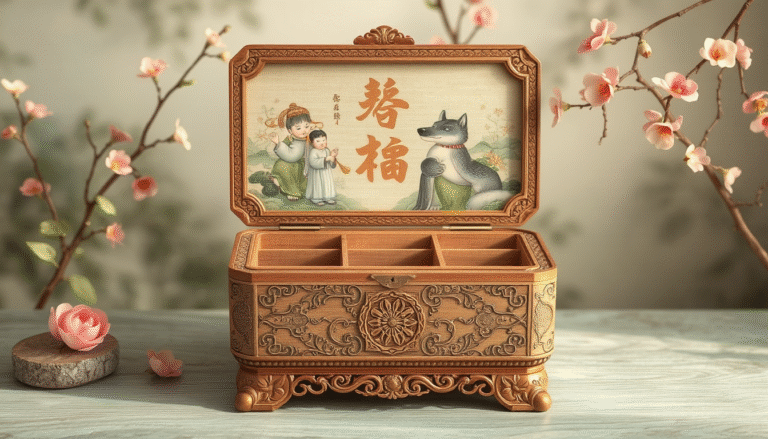Beyond Beauty: A An Introduction to a Cultural Treasure
A chinese jewelry box with jade is more than just a container for valuables. It combines art, function, and deep cultural meaning.
These special boxes show off many old traditions. You can see this in the carefully chosen woods, the shiny brass parts, and most importantly, the beautiful jade pieces on top. Each box is like a small monument to Chinese art.
This guide will explore everything about these treasures. We will look at their meaning, craftsmanship, and how to take care of them. We’ll also learn about their history and why people find them so fascinating.
The Soul of the Box: Unpacking the Symbolism in Wood and Jade
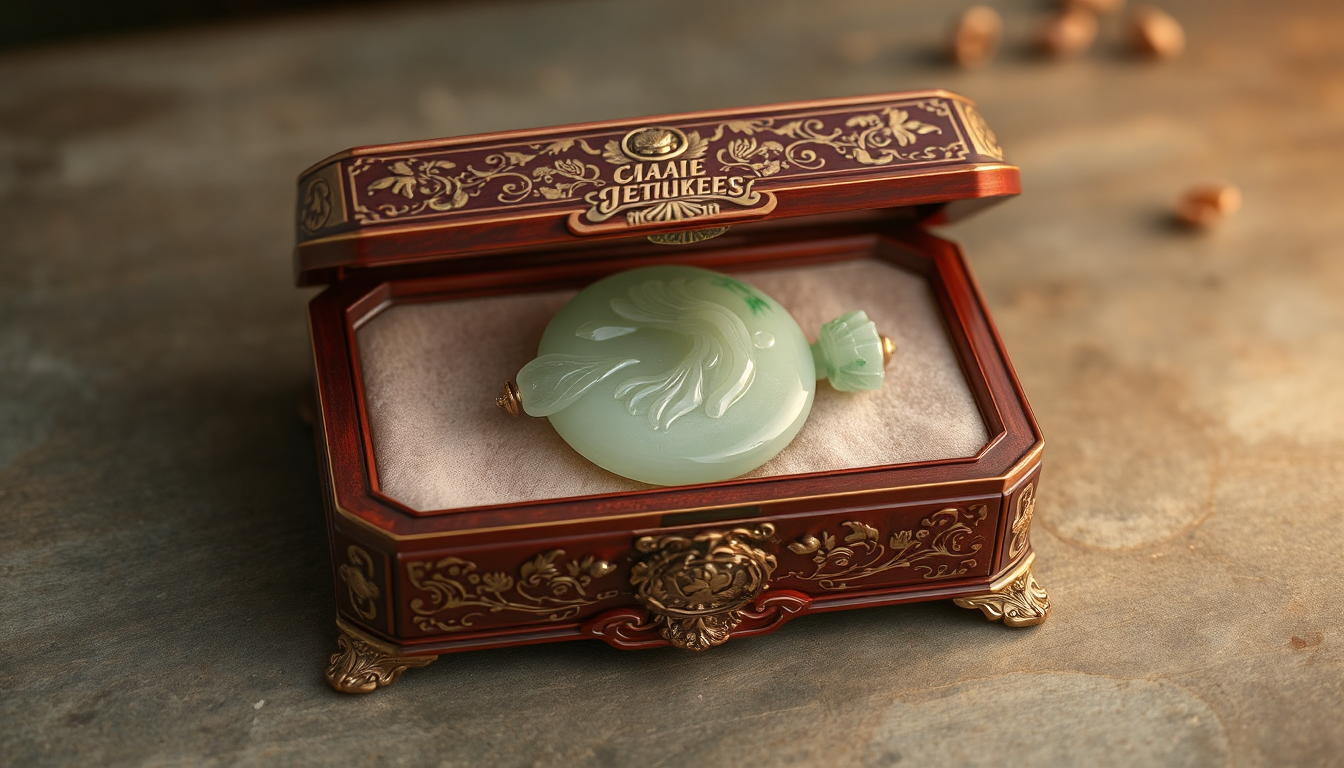
To appreciate a Chinese jewelry box, we really need to be able to understand the stories it tells. Each material and design serves a different function and brings positive thoughts to the recipient.
The Enduring Significance of Jade
Jade is the heart of the box. In Chinese society, jade is more than a stone. It symbolizes virtue, purity, wisdom, longevity and protection.
The belief that jade protects and brings good luck is very old. Experts note the deep cultural significance of jade in China, linking it to the highest human values. Jade feels cool and smooth to the touch, which was thought to calm the spirit. Its toughness symbolized lasting forever.
It is carved to be placed on a jewelry box as a guard. It guards the contents and the individual who wields the box.
Reading the Carvings: Common Motifs and Their Meanings
The designs carved into jade tell stories and offer blessings. When you know what these symbols mean, the box becomes more than just pretty—it becomes a personal good luck charm.
Here are some common designs and what they mean:
-
Motif: Dragon & Phoenix
-
Symbolism: Known as the “king of flowers,” the peony represents wealth and success along with love and honor. Its blooming means harvest and wealth.
-
Motif: Peony Flower
-
Symbolism: Called the “king of flowers,” the peony stands for wealth, success, love, and honor. Its full bloom shows richness and high status.
-
Motif: Bamboo
-
Symbolism: Bamboo is appreciated for its strength and flexibility. It bends in the wind but does not break, symbolizing strength, resilience and long life. It is a reminder to be strong in the worst of times.
-
Motif: Bats
-
Symbolism: There is a pun with the word. The Chinese word for bat happens to sound like the Chinese word for good fortune. So the images of bats simply wish for happiness and wealth.
The Vessel Itself: Wood and Brass
The wood matters, too. But really solid hard, dark woods like Rosewood were prized for their natural beauty, usually showing a more luxurious piece.
There is also camphor wood that was also a common choice. It’s great for carving and has a lovely, earthy smell that naturally wards off bugs, preserving both the silk within and treasures within the box.
The brass hardware — hinges, clasps, handles — do more than just function. The gold is a nice complement to the wood and jade. Their sturdy build represents safety and long life, which in turn makes the box a family heirloom that can be passed down generations.
A Collector’s Guide: How to Identify Quality in a Chinese Jade Jewelry Box
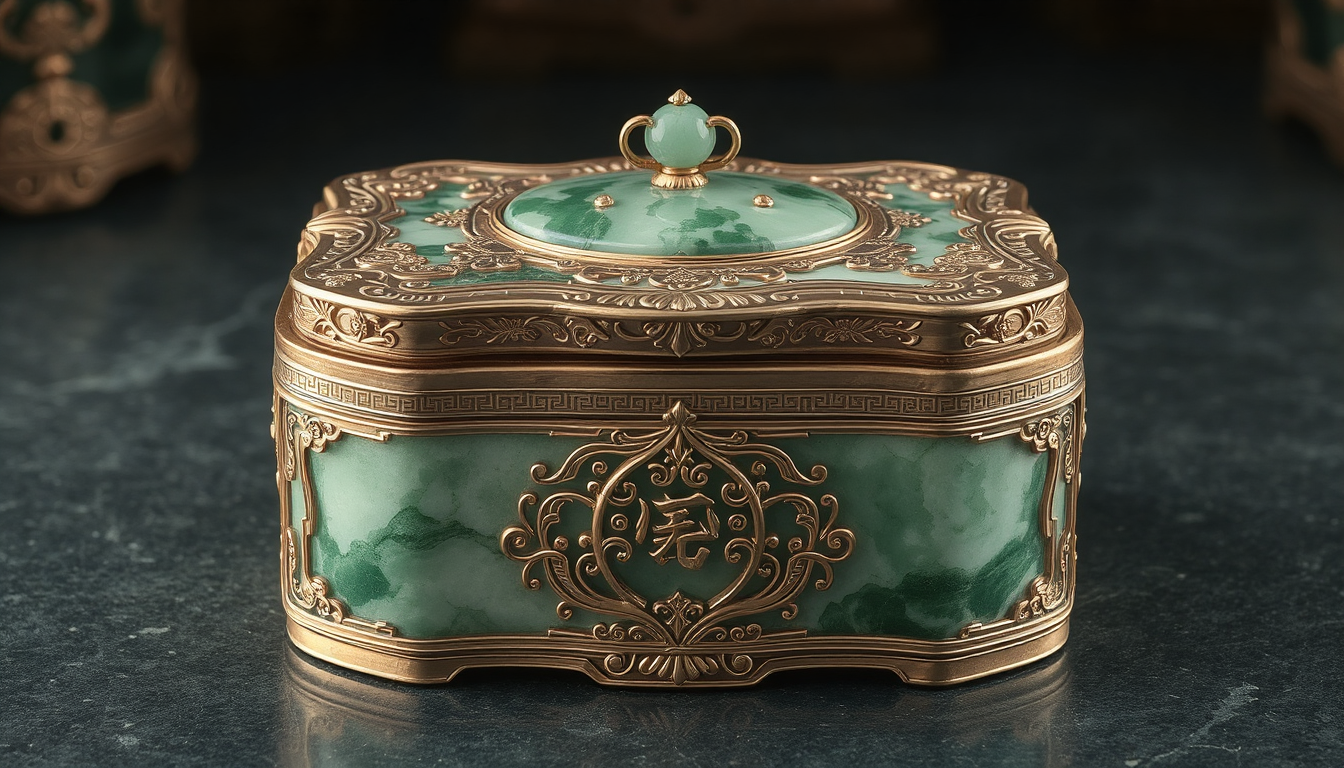
If you have one of these boxes, whether it be something you’ve collected or bought or that you’ve inherited, learning how to tell the good ones from the not-so-good ones is paramount. There are three major areas you must inspect: the jade, the woodwork and the hardware.
Evaluating the Jade Inlay
Sometimes The jade piece becomes the centerpiece, and is where the prize is shown.
First, look at the carving. Detail Let’s see some depth in the good work. The lines should be smooth without roughness or shallowness. Seek out some fine details that demonstrate the artist’s work and time. The outer surface must be polished to shine.
Now examine the stone in question. While jade appears in every color, an even, pure (color is) better than splotchy (color) or of uneven value. Fine jade is translucent, allowing some light to pass through and giving it a glow from within.
Finally, touch it. When rubbed against your skin, cool and smooth real jade feels heavy and cold, and will stay that way if held for some time.
Assessing the Wood and Construction
A lot can be read from how well it’s built a box up. Search for solid wood panels rather than thin veneers glued to inferior wood. The box is heavy and well-made.
Inspect the corners where pieces meet. Good boxes have perfect joints and fit perfectly together. The less good boxes will have no chamfering and straightforward joints, usually glued and nailed (with gaps visible).
Typical woods are reddish-brown Rosewood, dark Mahogany, fragrant Camphor. A well-maintained finish that highlights its natural wood grain characterizes a well-cared-for piece.
Inspecting the Hardware and Lining
The metallic parts are important details. Heavy, strong brass is of course the ideal of all good hardware. It should be firm, not flimsy or feeble. Keep an eye out for ornate touches like hand-carved patterns or whimsical shapes, such as butterfly or ‘ruyi’ scepter lock plates.
The clasp should function easily and close firmly. If there are handles, they must be securely fastened and sized to the box.
Don’t forget to look inside. A well-maintained interior is a good omen. Silk — often in lucky red or gold hues — lined many of the boxes. A clean, unbroken lining indicates that the box has been treasured and protected against damp and bugs.
Clues for Dating Your Box
Genuine antiques are few and far between, but most Chinese jade jewelry boxes known to be found in the West were made during the 1950s – early 1970s. These frequently were produced to sell to other countries.
These mid-20th century items (from the 1950s-1970s) have several characteristics. They can perhaps be constructed with less sophistication than the previous ones. A very common feature is the application of certain brass hardware, like etched, butterfly-style clasps that snap closed with a pin-like latch.
The patina on some of these works may appear artificially old to interest Western buyers in search of “antiques.” The jade carvings might be less intricate than the older ones, but they retain the old meanings. Understanding these characteristics is important for situating a box in history as a product of a particular era of cultural interchange.
Preserving a Legacy: How to Care For and Display Your Jewelry Box
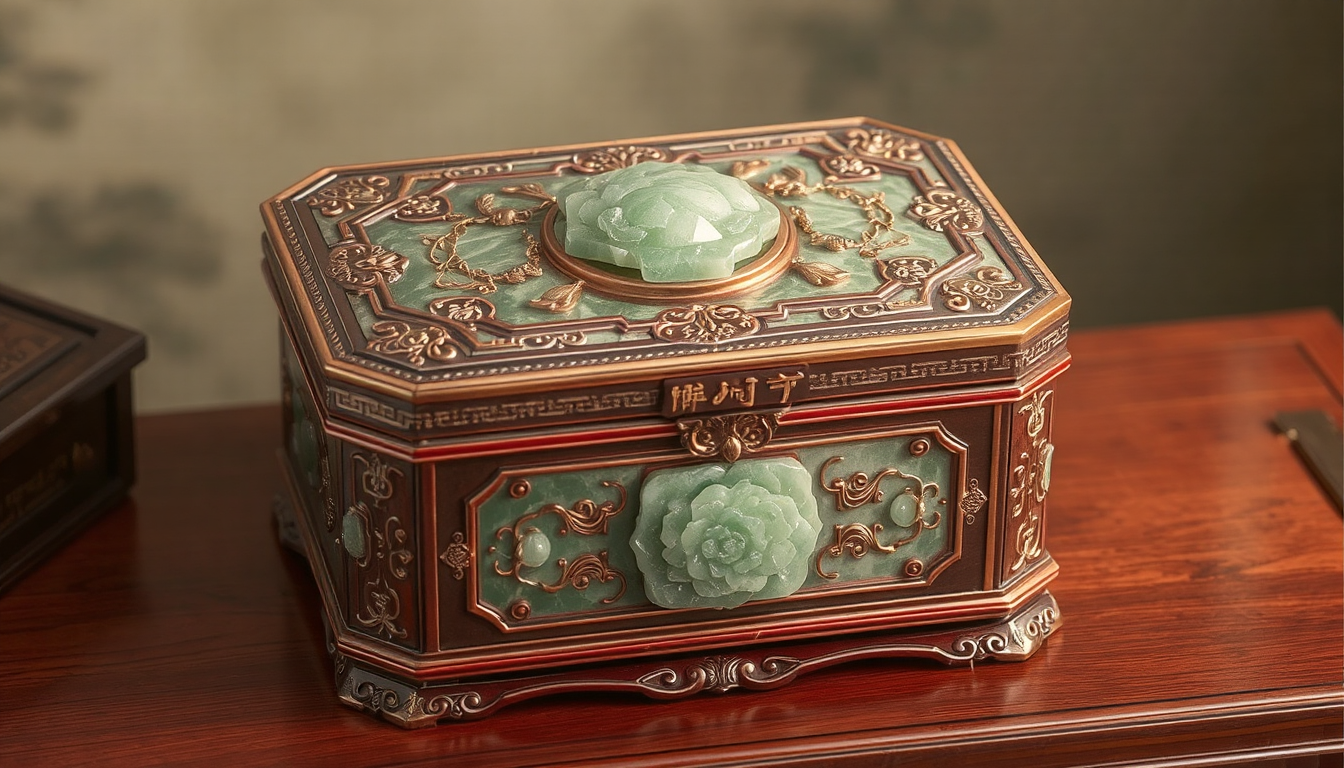
Taking good care of your chinese jewelry box with jade is essential. These objects are made from natural materials that can be affected by their surroundings. Following a gentle care routine will keep them looking beautiful for years.
We suggest a gentle approach. Harsh chemicals or rough materials can damage the wood finish, jade, and brass permanently.
A Gentle Cleaning Regimen
It works best to treat each material separately and carefully.
-
For the Wood: Wipe with soft dry cloth to clean dust. For harder to clean surfaces, you can lightly wet the cloth with water, wipe, then immediately dry the area with another clean, dry cloth. Avoid furniture sprays and oil-based cleaners, which can damage the original finish and leave a tacky film.
-
For the Jade: Dust off the jade with a clean, dry, soft rag or cloth.Cleaning the Jade: Wipe the jade with a soft, clean towel we had moistened with clear water. If your coin is extremely dirty, you could also add a single drop of mild soap to the water. Afterward, you must remove any soap with a clean wet cloth and dry the jade immediately to prevent water from getting into the wood around it.
-
For the Brass: If you would like to polish the brass, use a brass cleaner and apply very sparingly with a q-tip. Be very careful not to allow the cleaner to touch the wood or the jade, it will leave stains. Buff and polish a small portion at a time with a clean cloth.
Ideal Conditions for Storage and Display
Where you keep your box matters a lot. Keep it away from direct sunlight, as sun can fade the wood’s color and dry it out, causing cracks.
Also avoid places with big changes in temperature or humidity, like near heaters, air vents, or in damp basements. A stable, moderate environment is best for preserving both the wood and the delicate lining inside.
More Than an Object: Displaying Your Box with Pride
A chinese jewelry box with jade showing should be on open display. It is a thing of beauty to be viewed, appreciated, and treasured.
And it can even be the centerpiece of a dresser or side table where you can appreciate its fine details. It can also be pretty displayed on a bookshelf, mingled with books and other beloved objects. When you wear your box on your arm, it’s not just a container you are displaying — it’s a piece of cultural history and art.
A Journey Through Time: The History of Decorative Boxes in China
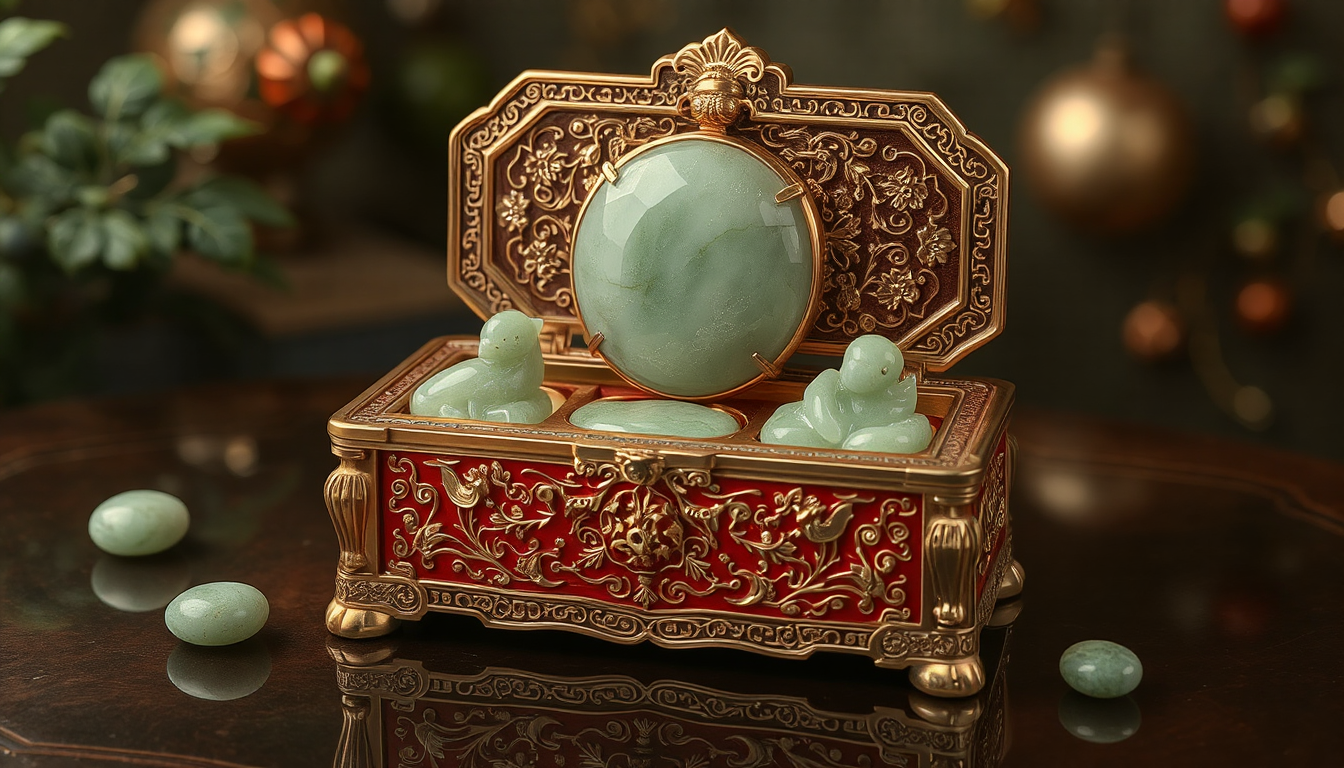
The chinese jewelry box with jade is part of a long history of decorative container-making in China. For centuries, artists have created beautiful objects for storing precious items, from writing brushes to imperial seals.
From Imperial Courts to Global Collectibles
The regimented pursuit of beautiful containers stretches back to ancient Han and Tang dynasty lacquerware boxes. These early works established a tradition of functional art that was concurrently beautiful and useful.
Over time, jade—a material once reserved only for the most sacred objects and symbols of power—began to be used in these decorative arts. It was a natural step, as Jade has been cherished as a symbol of virtue and vitality in China for thousands of years. Adding it to a personal item like a jewelry box made it more special and gave it protective energy.
The 20th century became a significant turning point. Meanwhile, the production of these boxes had surged. They were made for an evolving Chinese society as well as for expanding international markets captivated by “Oriental” designs. This export boom is the reason why such gorgeous vintage specimens have made their way to homes around the world today.
A Timeless Treasure for Generations
And we’ve looked inside what these boxes are for and what they represent. We’ve learned to read their materials for symbolism, to identify quality craftsmanship and how to care for them.
A chinese jewelry box with jade is much more than just a storage container. It preserves a culture, displays artistry that is careful, and contains living history you can hold in your hands.
It makes no difference whether it’s a family heirloom or a new piece in your collection, it is a legacy of beauty and meaning. It’s an eternal heirloom for generations to come – one that will continue to share its stories and blessing for generations.
FAQ
-
What makes a Chinese jewelry box with jade special?
A Chinese jade jewelry box is a work of art, a functional object and a piece of culture All of the wood and brass pieces have been carefully selected to enhance the jade every piece of jade represents virtue, purity, wisdom and protection. -
How can I identify a quality Chinese jewelry box with jade?
You’re looking for intricate jade carvings that follow smooth lines and give off a translucent glow, solid wood frame construction with tight-fitting joints, heavy brass hardware on the legs and around the edges and a pristine interior lining. -
What do the jade carvings on Chinese jewelry boxes symbolize?
Common themes are dragons and phoenixes (perfect marriage), peonies (wealth and honor), bamboo (endurance), and bats (good luck), each baring their own unique blessing to the wearer. -
How should I care for my Chinese jewelry box with jade?
Clean wood with a soft cloth (steer clear of harsh chemicals), wipe jade with water, polish brass hardware with care, and keep off sunlight and humidity. -
Are most Chinese jewelry boxes with jade antiques?
Most of the boxes encountered outside of China are vintage examples, dating from the mid-20th century (1950s-1970s in particular), with distinctive brass hardware, often more basic construction techniques and faux aged finishes at times.



